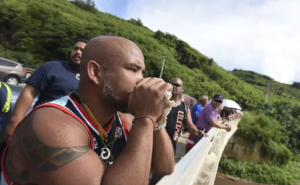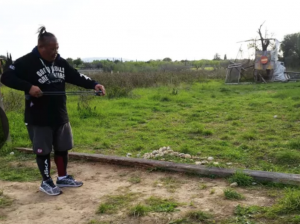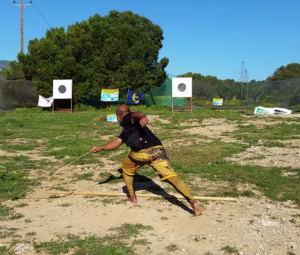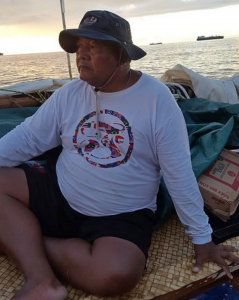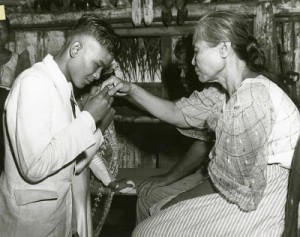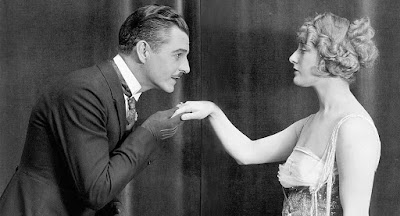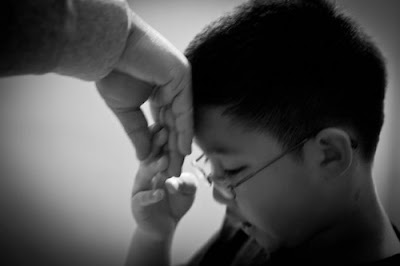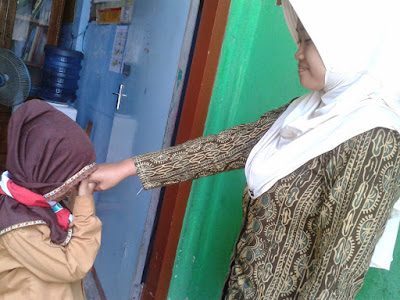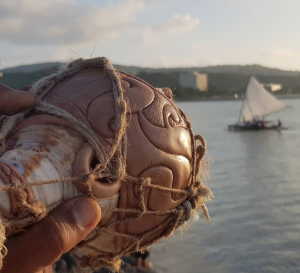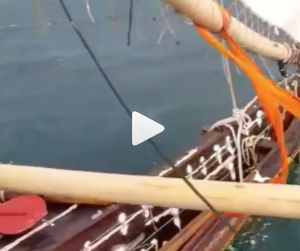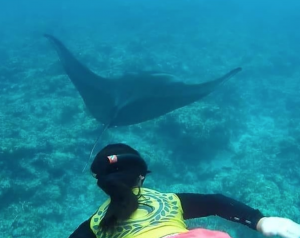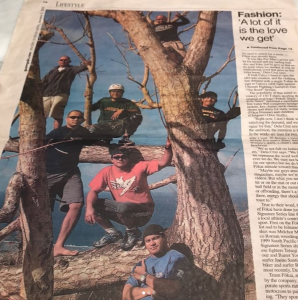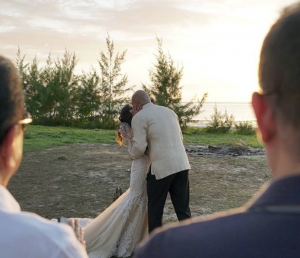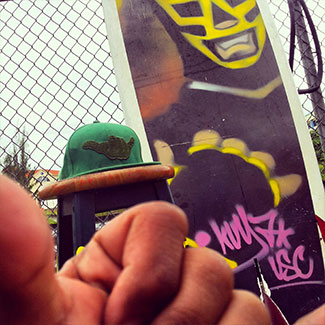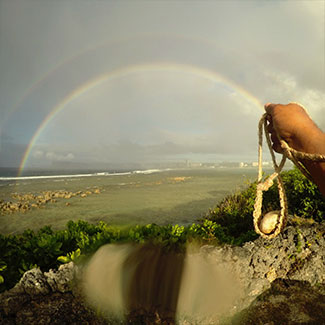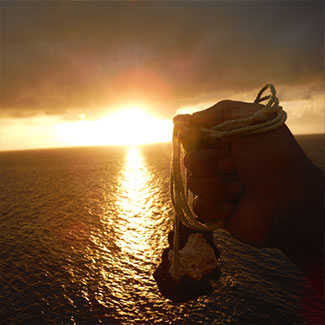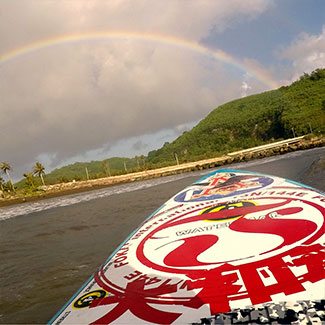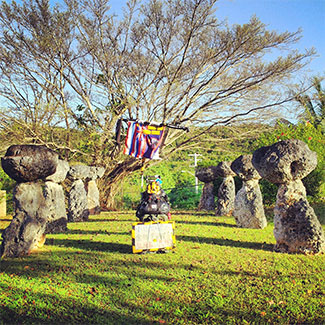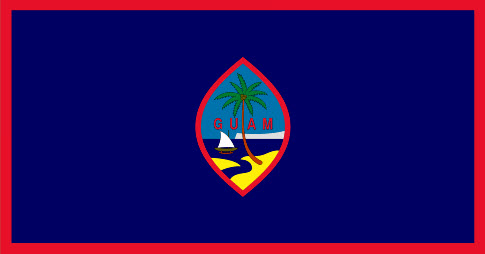Guam slingers compete in international tournament in Spain
September 14, 2018 by admin
Filed under Special Forces
About six months ago, Christian Sam Wirk of Austria turned the heads of our small group of stone slingers when he said there would be an international slinging tournament in Spain.
When he told us three months later that it coincided with the launch day of Chamorro month, that sealed the deal. As people of the only flag in the world that bears a sling stone, it was only proper that Guam be visible in the world’s largest stone-slinging event.
Since we felt ready enough and since slinging runs in our blood, we wanted to make a mark. We set the path. We reached out for support. Bound for Ireland and Spain, we aimed to sound the horns.
Thank you very much Tony Susuico of the Grasshopper Lounge , Paddy Quinian of FunkyTown, and JP at The Oar. Our journey through Ireland was epic on all accounts. Without their help, none of this would’ve been possible. It was a privilege to watch Guelu Rosario’s presentation on the Flying Proa in Ireland with our new seafaring friends in Croshaven. It was a great time to sling with him across the Emerald Isle, and it would be an honor to compete alongside him in an event considered the slinging world championships.
Still settling from an incredibly eventful 5 day adventure in Ireland on behalf of the Flying Proa — we barely made our flight through a tedious layover in London to eventually arrive Palma, Mallorca in Spain at 5:30 p.m. Feb. 25th.
Upon arriving at Hotel Horizon, we received information that there would be a smaller slinging tournament on the other side of the island at 11:00 a.m. the next morning. Neither of us had ever competed in a slinging competition before so we thought we’d give it a go. After a grossly underestimated and very expensive cab ride – we arrived dazed, confused and in the land of the lost in Chamorro time, 20 minutes late, to the Monasterio de Lluc. There we found triathlon and a whole array of other activities; but our hearts dropped when we were told that there was no slinging tournament available. After deciding, instead, to find ways to make the most of our 80 euro investment, we looked about 200m away from the premises to see two guys carrying slings. Apparently we arrived at the wrong destination. After a quick conversation, they pointed us further down the road where we arrived to see several people walking around selling hand made slings, competitors with sling club T-shirts, Officials with sling league vests, and generations and full families of slingers. Happily, we were convinced that we were at the world’s true mecca of sling culture and sport.
Arriving too late to compete, we stood out enough as spectators that we were invited by the event organizers to give slinging a try. They were excited when we replied by pulling our Guam-made slings out of our bags and became absolutely ecstatic when we revealed artifact sling stones that we also brought along from Guam for an around-the-world tour. After an electric and positive gathering over Guam’s artifact stones, the crowd goaded us to sling at the targets they had set for the competition. Guelu was on deck. I was right behind him. This was the time for Guam’s first slinging impression in Mallorca. Everyone was watching. They were happy to see that we knew well enough what we were doing and invited us to join them for the awards presentation at the center court of the festivities.
What happened after would set the pace for the trip. Guelu and I sounded the kulu shells we brought from Guam to congratulate a brand new friend that turned out to be a winner of the event.
This caught enough attention that in the process, we were introduced to Diego Camanas. The main pioneer of modern day Mallorcan slinging sport.
Diego was about 70 years old, and also a former multiple-time slinging champion. He, like everyone else there, had never heard of Guam. We were happy to change that. Thereafter we were invited and driven by some locals for target practice at their sling training ground in the nearby village of Inca. From the Pacific Ocean to the Mediterranean Sea—birds of a feather had flocked together and our trip of slinging and sharing culture in Mallorca officially took flight.
The people of Mallorca, Spain have been slinging stones for a very long time. As part of the chain of the the Islas de Baleares, or the Islands of the Throwers, their slinging history runs back as far as, or maybe even before, ours. Like us, Mallorcans also consider themselves islanders. As we peacefully distinguish ourselves from being labeled Americans, Mallorcans readily distinguish themselves from being called Spanish.
Like us, Mallorcans are a slinging people of the world and also for the sake of cultural revival, they are also trying to expand their slinging culture.
After target practice with our new hosts, Perek, Ivan and his wife Marina, we were invited to join them on a tour of their hometown of Alcudia. They brought us to sling with them at Illiot, a slinger’s fantasy pebble-stone beach with an unlimited supply of what has to be the world’s best natural slinging ammunition. The four of us spent about an hour trying to stone down a water bottle 20 yards for a ridiculously low-success rate. Laughingly and with relief, it was comforting to know that even seasoned Mallorcan slingers could just as often miss their target.
We spent the next day visiting the Le Seu Cathedral in Palma, we were excited to bring stone offerings to the famous “Es Foner” slinger statue. It was awesome to see another culture that could wrap themselves around a sling stone as we have. After two hours of walking, taking photos and some really good coffee, we walked into an antique book and artifact shop named Nottingham Books.
There we found artifacts and relics from all over the world explained to us in detail from their collector Rodney, the world’s most interesting man.
We returned to Inca for another training session with even more of the locals, where we were also able to sling with world famous sling-maker Uwe Hubert, and with one of Mallorca’s most skilled competitors, Paco — known to us forever as the really good slinger dude with the long ponytails.
March 1st, it was time. After a decent night’s rest, an awesome sunrise and a filling breakfast, we were corralled with slingers from the other visiting countries to jump on a bus that drove us to the competition grounds at the Fuerte de San Carlos, an ancient battleground on the perimeter of an old military fort.
The venue today, overlooking the Mediterranean Sea and the coastline of Palma was a pumped-up version of that first day tournament. There were a few more sling makers, a whole lot more competitors, and even more spectators gathered to participate in the “IV Encuentro Internacional Tiro con Honda.”
Game day
Everything that had happened in Mallorca up to that point had already made the trip more than worth the efforts and expenses to get there. When Guelu and I were given the great honor of blowing our kulu shells to assemble the competitors and to start off the event, this completely unexpected ancestral connection was more than we could hope for.
On Guam’s first step into international sling sport – using a coconut fiber sling made on Guam and with pugua in chew – Guelu Rosario hits a bullseye. An international bullseye.
Fanoghe Chamorro! Legend! He would go on to hit the board another three times, but it wasn’t enough to place.
After near-daily slinging the last five years, even though I never really trained for specific target practice, I felt confident enough going into the event. Unfortunately, it was confidence misplaced.
From my first practice throw through the competition rounds, I never found a groove. The first shot I missed, the second shot I came close, the next I missed again. In front of about 150 competitors, spectators and officials, I repeated this round after round. After almost 30 hours in actual travel, on the day where it seemed to matter most, I arrived at the other side of the world to shoot 0 for 30 in front of the performers of the world slinging community.
Stone cold rock bottom… I slung a perfect game. Perfectly wrong. Perfectly embarrassing, and humbling for sure. But it was also oddly motivating.
Culturally driven but competitively severely inadequate, I could have and should have done things differently. But, it is what it is. Forward I go.
Today, 15 slinging countries know our name. Guam has made its slingling mark, and the first in Mallorca is a Guelu bullseye.
We have faith that Guam and the Mariana Islands will become a great asset to world slinging sport. The wheels are in motion. Our success is literally just a stone’s throw away.
Guelu will be back and so will I, and hopefully with others in tow. Again and again. For Guam’s honor.
Thanks for dropping by.
Demetrius Might Mouse Johnson. Soul of a Champion
August 12, 2018 by admin
Filed under Special Forces
Soul of a champion: This past weekend saw one of the greatest UFC champions ever lose his belt in an extraordinarily close bout after a record eleven title defenses. This post is not about the match, how it should have been scored or whether Demetrious Johnson is the best pound for pound fighter in the world. This is just about how we all can improve ourselves by looking at Mr Johnson as a role model. When I first started seeing Mr Johnson at UFC events he showed inconsistent brilliance. He beat Japanese Superstar Norifumi Yamamoto to show he was a great talent. Then in his next match against Miguel Torres he showed great takedowns but then got swept into mount on multiple occasions. Yet despite the early flaws – EVERY TIME HE WENT OUT TO COMPETE YOU COULD LITERALLY SEE THE FLAWS BEING REPLACED BY NEW STRENGTHS. He had the work ethic and in conjunction with his coach Matt Hume, the wisdom to see what needed to be improved and the best way to do it. This was an athlete who was not satisfied with winning. He recognized that only flawless wins would give him the resources he would need later at championship level. The second great trait that I saw in him was his overall positivity. Mr Johnson had a hard upbringing and many personal difficulties in his life that he never talks about. He could legitimately feel encumbered by them – but never does. I have never met a person so strong in his ability to see positive elements in challenging circumstances. For him, everything was a blessing and a test of his character to be surpassed through self improvement. This is a man who dominates the circumstances of his life through his positive attitude rather than allow the circumstances of his life to dominate him. We don’t know much about the future – but for person with traits like these – it’s always forward
Master navigator leads canoe voyage. Article by: Marianas Variety
July 9, 2018 by admin
Filed under Special Forces
Master navigator leads canoe voyage. Article by: Marianas Variety
By Sophia Perez – sophia@mvariety.com – Variety Features Writer
The traditional Chamorro sakman Fanhigåyan Guåhan returned to Guam last Sunday after sailing to Saipan and back.
Palu or Master Navigator Ali Haleyalur of Lamotrek led the voyage, working alongside Traditions Affirming Our Seafaring Ancestry (TASA)to revive seafaring traditions in Micronesia.
TASA aims to develop and support the documentation, research, and teaching of Micronesian cultural heritage, create local and regional opportunities for capacity building in traditional seafaring and navigation practices and promote Micronesia’s seafaring heritage through tourism.
“The passion for anything can only be transmitted through its practice,” said TASA President Sandra Iseke Okada.“Revitalization requires capacity building in these threatened and/or disrupted traditions. This open ocean voyage is also about building the capacity of Guam’s traditional seafarers.”Along with Okada and Palu Ali, the Fanhigåyan Guåhan crew included Jesse Piyelur (Lamotrek), Johannes Hashigluw (Lamotrek), Vicente “Gue’lu” Rosario (Luta), and Ned Pablo (Guåhan).They were escorted by Captain Cecilio Raiukiulipiy’s SV Remedy, crewed by Innocenti Eraekaiut (Satawal, FSM), Glenn Rafifimwai (Satawal, FSM), Scott Suzuki(Chuuk, FSM), Andrea Carr (Japanese American), and Cecelia Selepeo (Pagan).
The voyagers set sail on Sunday, May 13 and stopped in Luta, where, according to Palu Ali, they received something akin to a hero’s welcome.
“It was so nice in Rota,” he told the Variety. “Once we cleared customs, the villagers brought food and offered cars and that evening they kept bringing us deer and fish…The mayor was first and hosted meals at restaurants on multiple occasions.”
“It doesn’t matter where you go in Rota, people greet you and act like they know you, offer food and drinks,” he continued.“It’s so beautiful. I would love to stay there. It’s still not spoiled by Western ways…it’s still traditional. I love it.”
The crew enjoyed Luta’s generous hospitality for two days before heading to Saipan, where they were met with the considerable rainstorm that hit the island on the 17th.
PaluAli said that Fanhigåyan Guåhan threatened to sink in the heavy rains, and the crew only narrowly managed to bail out the canoe. Finally, at 5pm, the Fanhigåyan Guåhan crew was received at a welcome barbeque in Susupe hosted by friends, family, and members of the canoe community.
Reflecting on the first half of the trip, Palu Ali said, “I was really excited because this is my first time sailing from Guam to Saipan and I really wanted to explore these sea lanes.”
Sea lanes are ocean routes that boats take from one landmass to another.
“The crew was good, everyone got along, they all listened to my orders so I was very happy with them,” Palu Ali added. He also offered some insight on his navigation methods:
“Going from Guam to Rota I can use the islands as a reference point,” he explained,“but between Rota to here [Saipan] I made an imaginary reference island – I created a reference point in the stars and kept checking back…to know how far I was from my point of departure.”
TASA exists to preservenavigation methods like this one; without traditional navigation knowledge, Micronesians will be forced to rely on Western technology and culture to travel across their own ancestral lands.
But Uncle Ali, who teaches a navigation school in Yap, is confident that navigational knowledge will carry on to the next generation of islanders.
“I think what we are doing now will trigger the young ones to start learning traditional navigation,” he told the Variety. “I want them to remember all these things because otherwise Western influence will cause this to fade away. I want them to have both.”
“When they become navigators themselves, they will be very happy.”
Palu Ali Haleyalur will remain in Guahan for a week before returning to Yap. The crew of SV Remedy will sail back to Saipan in the coming days. As for TASA, the organization continues to barrel forward with its vision.
“To further efforts in achieving our mission, TASA has just been entrusted with the canoe house located at the Paseo de Susanna,” Okada said.“Our organization will be refurbishing the canoe house and begin hosting an ‘open house’ every Wednesday evening to showcase to visitors and locals alike the revival of our ancient seafaring tradition.”
THE MAN NGINGE’ Spanish Origin? Not? By: Pale Eric Forbes
June 13, 2018 by admin
Filed under Special Forces
THE MAN NGINGE’ Spanish Origin? Not? By: Pale Eric Forbes
Recently, I noticed a good number of comments on Chamorro culture social media sites stating that the man nginge’ is a Spanish custom.
None of the people claiming this provide any historical evidence. How can they? It isn’t there.
Consider the following :
1. Early European accounts of our ancestors describe different gestures of respect practiced among our ancestors before Spanish colonization.
Just to cite one early source, the Jesuit Francisco García, writing very early during the first decades of Spanish colonization, whose sources were the letters and reports written by the Spanish missionaries on the ground here in the Marianas.
García says, “They (the Chamorros) practice many courtesies, and an ordinary usage on meeting and passing in front of one another is to say ‘ati arinmo,’ which means ‘Allow me to kiss your feet.’”
He also says, “To pass the hand over the breast of the person they visit is a great courtesy.”
So we notice here no mention of taking someone’s hand and “kissing” it with the nose, which is how we have practiced the man nginge’ for at least a couple of hundred years, if not longer.
But we do see that our ancestors did have gestures of respect which involve kissing (with the nose?), the feet, the hands and the breast or chest.
Ati arinmo, by the way, is the way a Spaniard spelled what he heard with his Spanish ears. And even this differed from Spaniard to Spaniard, one Spaniard spelling a Chamorro word one way and another Spaniard spelling the same word a slightly different way.
Some suspect, as I do, that arinmo is actually addeng-mo. Addeng is the Chamorro word for foot or feet. (On Guam, this has been replaced by the Spanish loan word påtas, which means the feet or paws of animals.)
2. Spaniards do not have, nor ever had as far as we can tell, the ordinary custom of kissing, much less with the nose, the hand of an elder, authority figure or higher status person.
Bishops and the higher clergy wore rings and it was that which people kissed. The rings were symbolic of the church dignitary’s spiritual marriage to his diocese. In certain situations, political or military leaders had their rings, or hands, kissed with the lips as a sign of loyalty by subordinates.
Women, especially of the higher class, would sometimes extend their hand to be kissed. But this was always at the invitation of the woman. In Chamorro culture, the subordinate always makes the first move, reaching for the hand of the saina or superior.
Kissing was done with the lips, and sometimes the lips never even touched the hand. But the kiss was never made with the nose, while Chamorros kiss with the nose.
3. Our close neighbors, the Filipinos, practice a similar custom that is accepted as a pre-Spanish gesture.
By “close” I mean we have common racial and linguistic roots and many similar customs and values.
The Filipinos practice their own gesture of respect by taking the hand and placing it on the forehead, rather than on the nose or the mouth.
Early Spanish descriptions of the Filipinos indicate that this was already a custom before Spanish influences took root there.
4. Indonesians and Malays also practice the gesture.
If one argues that the gesture is Spanish in origin, because both the Marianas and the Philippines were colonized by Spain, how then does one account for the fact that the Indonesians and the Malays (not everyone in Malaysia is Malay) also practice it? Neither Indonesia nor Malaysia were ever Spanish colonies.
Like the Filipinos, Malays and Indonesians take the hand to the forehead, but, according to some writers, the hand is sometimes “kissed” with the nose, but never with the lips, the same way Chamorros avoid using the lips.
5. Borrowed terms do not necessarily mean borrowed actions.
Perhaps some people think the gesture is Spanish-based because the gesture is accompanied by Spanish loan words. When one reverences the hand of a man, one says, “Ñot,” which is short for Spanish “señor,” or “sir.” For a woman, “Ñora,” short for “señora” or “madam.”
But all that shows is that, at some point, Chamorros adopted some Spanish forms of address.
The Filipinos also borrowed the Spanish word mano, or “hand,” and call their form of hand-reverencing the mano po. That phrase is a combination of Spanish manoand Tagalog po, a term of respect.
The Indonesians and Malays call their hand gesture the salim, which might be borrowed from Arabic (Malays and Indonesians are overwhelmingly Muslim). But the gesture itself is not Muslim nor Arab.
My opinion….
Since the Spaniards themselves did not practice it; since it is not practiced in any former Spanish colonies in Latin America; since the gesture (with minor variations) is practiced by peoples with geographic and cultural affinities (Chamorros, Filipinos, Malays/Indonesians); since the gesture never involves the lips (something more European); since old accounts describe gestures of respect practiced prior to Spanish colonization, I am most comfortable saying
1. The gesture is not Spanish in origin.
2. The roots of the man nginge’ lie in our pre-contact indigenous culture because early accounts do speak of other gestures of respect, so at least the roots and the cultural values were already in place before colonization.
3. Since Ñot and Ñora are Spanish loan-words; since the early accounts do not describe the reverencing of hands but rather other gestures of respect; these earlier gestures evolved over time, at least as far as the terms of address are concerned, and perhaps even the manner (from reverencing feet to reverencing hands).
4. It is possible that our ancestors did reverence the hand, even though European writers did not document it. After all, García says the Chamorros of the 1600s practiced “many” courtesies, although he details only three of them.
5. It is possible that, in pre-contact society, reverencing the feet was reserved for special situations and that reverencing the hand was the norm, although the verbal formula “Allow me to kiss your feet” remained. This is similar to the old custom of ending a letter in Spanish with “I kiss your hand” even though that was not meant literally.
Other than that, I think we are on shakier ground drawing other conclusions. Many of my own conclusions are couched in words like “perhaps” or “possibly” because coincidences and similarities alone are not sufficient to prove connections.
Good history involves good evidence. And alas, good evidence is absent more often than not.
Successful trip by the Fineghayan! BIBA and Congratulations TASA!
May 28, 2018 by admin
Filed under Special Forces
Successful trip by the Fineghayan! BIBA and Congratulations TASA!
BIBA! Congratulations to TASA, the crew of the Fineghayan, and to the people of the Mariana Islands for another successful voyage on a locally made traditional vessel using celestial navigation and other methods of traditional way-finding.
Key to growing the interest and pursuit of traditional way finding in our island— —Special thanks and respect to Lamotrek and the other islands of the CNMI who have been able to keep these methods intact a d active for hundreds if not thousands of years.
#fanoghechamorro
#fokaiamphibiousdivision
#justaddwater
CLICK ON THE RIGHT ARROW TO VIEW PHOTOTS AND VIDEO!
Traditions Affirming our Seafaring Ancestry. SAKMAN!
May 17, 2018 by admin
Filed under Special Forces
Traditions Affirming our Seafaring Ancestry.
Big respect for TASA amd all the other contributing organizations out there that are wotking hard to reinvigorate traditional sailing and out raditional vessels.
With more than 4000 years of history. The people of the Mariana Islands were incredible craftsman and seafarers.
Despite the unstoppable reality of modernization Great to see the voices and teachings of our ancestors continues to resonate among us.
May our mistakes today provide solutions for those that might choose to follow.
Photo of the Week! MIA LEE with Manta Rays in Tumon Guam
May 1, 2018 by admin
Filed under Special Forces
An article resurfaced from 2002 Pacific Daily News
April 27, 2018 by admin
Filed under Special Forces
An article resurfaced from 2002 Pacific Daily News
Fokai for years was misconceived a sa fight geoup, though we were heavily connected into martial artd and venturing into combay sport, “Team Fokai” actually consisted of an array pf different athletes.
Consisting of an assembly of some of Guams top performers, Here is an assembly of some of our first official ambassadors Melchor Manibusan (wrestling) our very first sponsored athlete, along with Stephen Roberto (jiujitsu) Ron (mountain biking) Pete Alvarez(motocross) and Joeito Santiago (surfing). also pictured is Chief Satellite distributor-at-the time VJ Santos
#teamfokai
#itsafamilything
#sinceeversince
Marianas Open attracting World Class Jiujitsu Athletes and Competition
April 24, 2018 by admin
Filed under Special Forces
Marianas Open attracting World Class Jiujitsu Athletes and Competition
All around the world The reputation of Guam jiujitsu is tremendous. The character of our people training and competing all over the world has been backed with the many so fierce in international jiujitsu competitions.
In many ways it has created Guam as a mecca for #jiujitsuinparadise After a decades worth of trial, error, and evolution–the locally promoted Marianas Open
has grown largely ro bring opportunity to Guam a to cultivate and landmark Guam as a land of opportunity and a prime destination for world jiujitsu.
Keeping world class opportunity on the home court, this access our entire jiujitsu community to grow beyond the confines of a being a tiny dot in the Pacific.
Social media messages, phone calls from around the world, extended conversations with jiujitsu players around the world resonate an epic accolade of some type of rrmarkable Guam story. Amazing.
The world is truly watching.
Congratulations Brandon & Jessica Vera 4.20.18!
April 24, 2018 by admin
Filed under Special Forces
FOR LIFE:
An incredible time for an unbelievsble gatheriing of amazing people in a paradise thst wont quit.
Guam is proud to host you on your special day. 4.20.2018!
CONGRATULATIONS Brandon and Jessica Vera for a fantastic celebration of love, life, and adventure.. #happilyverafter
#forlife
#itsafamilything

